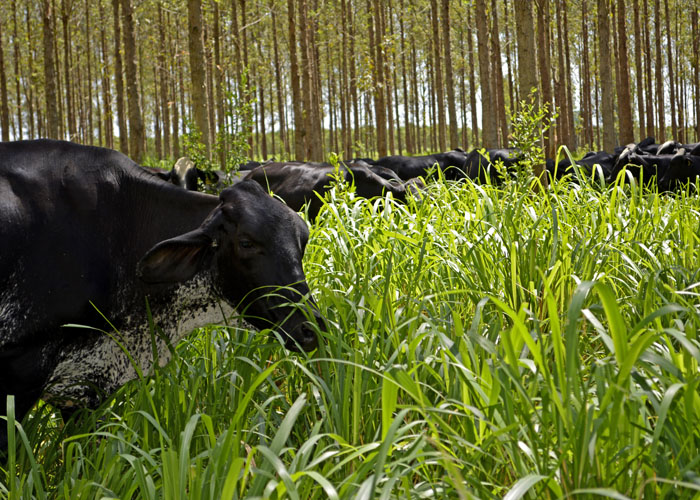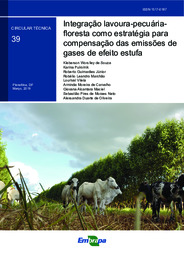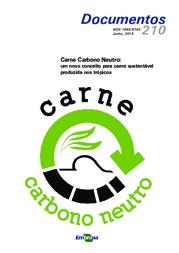 Busca de Notícias
Busca de Notícias
Farm GHG emissions neutralized with a mere 15% of land in ICLFS
|
The Integrated Crop-Livestock-Forestry System (ICLFS) implemented in only 15% of the production area was enough to compensate all the greenhouse gases (GHG) emitted by the animals and the pasture, leaving a carbon surplus in the farm. This result was recorded in research led by Embrapa Cerrados, and proved that the production of animals, trees and crops/pastures in the same space has high potential to generate carbon surpluses.
The study aimed at verifying ICLFS capacity to mitigate GHGs emitted by farming, and especially cattle farming. The study used two experimental areas, with carbon balance measurements. Published in a Technical Circular, the results show that the tree component is fundamental to increase carbon stocks in the property.
An ICLF system with a population of 417 eucalyptus trees per hectare - distributed in rows in only 15% of the area of the property - has the potential to neutralize methane emissions (CH4), produced by bovine enteric fermentation, and nitrous oxide (N2O), released from the soil and from animal excrements (urine and feces).
“For the GHG compensation to occur, a property with a thousand hectares of pasture, for instance, has to assign 150 ha to the ICLF system with 417 trees/ha and a stocking rate of 1.7 head/ha”, details the Embrapa researcher Kleberson de Souza. CIf the system was a crop-livestock one (without trees), the farmer would have to allocate 850 hectares of the same property to be able to mitigate the emissions, considering a stocking rate of three head per hectare.
The specialist also observed that the amount of trees can be smaller, as long as the ICLF system is adopted in the entire production area. In that case, it is possible to maintain approximately 70 trees per hectare, with a stocking rate of 1.7 head/ha, that is, 0.7 animal unit (AU). The stocking rate concerns the number of animal units (AU) that can be placed in a hectare and each AU corresponds to 450kg of live weight.
The studies were conducted in an ICLFS experiment established in 2009 at the Embrapa unit located in Planaltina, DF, Brazil. In the area, they measured soil emissions, methane (CH4) emissions due to animal enteric fermentation, and soil and plant biomass carbon stocks. Animal excreta release nitrous oxide (N2O) after being deposited on the soil, and hence contribute to increasing GHG emissions in cattle farming. Despite the lower concentrations in the atmosphere, nitrous oxide has an impact potential 310 times higher than carbon dioxide (CO2), on top of how long it remains in the atmosphere, 150 years.
Emissions in each stage of the experiment
At the stage of system implementation (agroforestry stage), when eucalyptus is intercropped with crops, the interference of the forest component was low, and nitrous oxide emissions (1.06 kg of N2O/ha) were attributed to the cultivation of grains (soybeans and sorghum). Later at the silvopasture stage (integrated cattle and forest component), the ICLF system's pasture annually emitted 1.02 kg of N2O, and the ICL system, 1.42 kg of N2O. On the other hand, two years after the experiment was established, enteric methane (CH4) emissions totalled 2.672 kg of carbon-equivalent per hectare a year for the ICLF system, and 4.072 for the ICL system.
Methane emissions in the production system vary depending on the area's stocking rate and the quality of the pasture ingested by the animals. In an area with ICLFS, the stocking rate is smaller than an area without trees (ICL system). Hence there is trend is for less emissions of the gas in those cases. In the experiment analyses, the ICLFS stocking rate was 1.7 head/ha (1.1 animal unit - AU), which culminated in an emission of 2,000 kg of CO2eq/ha/year as CH4. Meanwhile, in the ICL area, the stocking rate was of three head/ha (2.0 AU- animal unit), which yielded an emission of 3,400 kg CO2eq/ha/year as CH4.
Photo: Lílian Alves
The importance of trees in the balance
The studies proved that in order to have a significant carbon surplus, the forest component needs to be inserted in the agricultural production system. Because trees have high capacity to store carbon. "There are few uncommon cases in which C stocks in agricultural soils surpass the stocks in the adjacent native vegetation. That is, it is difficult to obtain a carbon surplus if the forest component is not inserted in the agricultural production system”, affirms the researcher Kleberson de Souza.
At Embrapa Cerrados ICLFS experiment, a single hybrid tree of Eucalyptus urograndis species at seven years of age was able to accumulate an average of 30.2 kg of C/year (considering 45% of C of dry matter biomass from the plant's aerial portion). This is equivalent to annually sequestering 110.5kg of CO2 from the atmosphere per tree in the system. In the ICL system, this type of carbon sequestration mostly occurs due to the pasture roots system and the mulch deposited onto the soil, and it tends to stabilize with time.
According to the experts, while on the one hand it is possible to say that an ICLF system will be more productive to sequester carbon from the atmosphere the more trees per hectare the system has, on the other hand, farmers should have caution so that an excessive number of trees does not have a negative impact on the remaining components, “especially the pasture, due to competition for light, water and nutrients”, underscores the researcher Karina Pulrolnik, also from Embrapa Cerrados.
The study also included the researchers Roberto Guimarães Júnior, Robélio Marchão, Lourival Vilela, Arminda de Carvalho, Giovana Maciel, Sebastião Pires and Alexsandra Duarte.
Translation: Mariana Medeiros
Juliana Caldas (MTb 4861/DF)
Embrapa Cerrados
Press inquiries
imprensa.cerrados@embrapa.br
Phone number: +55 61 3388-9891
Liliane Castelões (MTb: 16.613 /RJ)
Embrapa Territorial
Further information on the topic
Citizen Attention Service (SAC)
www.embrapa.br/contact-us/sac/




